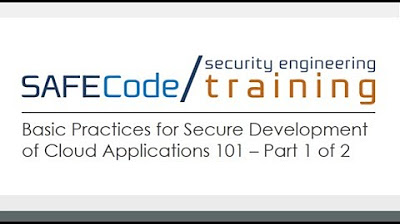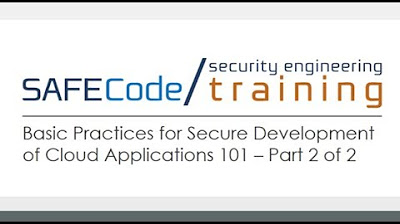The shared security model
Summary
TLDRThis video explains the shared security responsibilities between Google Cloud and its customers. While Google handles lower layers like physical security, disk encryption, and network integrity, the customer remains responsible for higher layers, such as securing data. Google provides tools like Identity and Access Management (IAM) and resource hierarchy to assist with policy implementation and data access control. However, customers must properly configure these tools to protect their data, emphasizing the importance of their role in ensuring security in the cloud environment.
Takeaways
- 😀 Security in the cloud is a shared responsibility between the customer and Google Cloud.
- 😀 When using on-premises infrastructure, customers are responsible for the entire security stack, from physical security to data encryption and network integrity.
- 😀 Google Cloud handles lower layers of security, such as physical security, disk encryption, and network integrity, when applications are deployed to the cloud.
- 😀 The customer remains responsible for securing the upper layers of the security stack, including data security and application content.
- 😀 Google provides tools like resource hierarchy and IAM (Identity and Access Management) to help customers define and implement security policies.
- 😀 Data access is a customer's responsibility; they control who or what can access their data in Google Cloud.
- 😀 Customers must configure tools like IAM properly to protect their data effectively.
- 😀 Google Cloud helps manage security layers but ultimately places the responsibility of securing the upper layers on the customer.
- 😀 Physical security and network integrity are handled by Google Cloud, while customers are responsible for their application data security.
- 😀 Customers should use Google Cloud's tools to manage security access but must ensure proper configuration to safeguard their data.
Q & A
What is the main focus of the script?
-The script focuses on explaining the shared security responsibilities between Google Cloud and its customers, particularly in terms of the different layers of security that are handled by Google versus those that remain the customer's responsibility.
What security responsibilities do customers have when deploying applications to on-premises infrastructure?
-Customers are responsible for the security of the entire stack, including physical security of hardware, premises security, data encryption on disk, network integrity, and securing the content stored in applications.
What security responsibilities are transferred to Google Cloud when deploying applications to the cloud?
-Google Cloud handles many of the lower layers of security, such as physical security, disk encryption, and network integrity. However, customers still need to manage the higher layers of security.
Which layers of security are customers still responsible for when using Google Cloud?
-Customers are still responsible for the upper layers of security, including securing data, controlling who has access to their data, and defining security policies for their applications.
What tools does Google Cloud provide to help customers manage security?
-Google Cloud provides tools like the resource hierarchy and Identity and Access Management (IAM) to help customers define, implement, and manage security policies effectively.
How does Google Cloud help with controlling access to data?
-Google Cloud provides Identity and Access Management (IAM) tools that help customers control who or what has access to their data, but these tools need to be properly configured to ensure proper protection of the data.
Why is proper configuration of IAM important?
-Proper configuration of IAM is crucial because it ensures that the customer's data is protected and that only authorized users or services have access to it.
Who is responsible for securing data in the cloud?
-The customer is responsible for securing their data in the cloud, even though Google Cloud provides the tools and infrastructure to help manage security.
Does Google Cloud secure data access by default?
-No, Google Cloud provides tools to help control data access, but customers must configure those tools properly to ensure their data is secured according to their needs.
What is the shared responsibility model in Google Cloud?
-The shared responsibility model in Google Cloud means that Google is responsible for securing the underlying infrastructure (e.g., physical security, disk encryption, network integrity), while customers are responsible for securing their data, applications, and access controls.
Outlines

هذا القسم متوفر فقط للمشتركين. يرجى الترقية للوصول إلى هذه الميزة.
قم بالترقية الآنMindmap

هذا القسم متوفر فقط للمشتركين. يرجى الترقية للوصول إلى هذه الميزة.
قم بالترقية الآنKeywords

هذا القسم متوفر فقط للمشتركين. يرجى الترقية للوصول إلى هذه الميزة.
قم بالترقية الآنHighlights

هذا القسم متوفر فقط للمشتركين. يرجى الترقية للوصول إلى هذه الميزة.
قم بالترقية الآنTranscripts

هذا القسم متوفر فقط للمشتركين. يرجى الترقية للوصول إلى هذه الميزة.
قم بالترقية الآنتصفح المزيد من مقاطع الفيديو ذات الصلة

AWS Shared Responsibility Model

SAFECode Basic Practices for Secure Development of Cloud Applications 101 Quiz Part 1 p3

SAFECode Basic Practices for Secure Development of Cloud Applications 101 Quiz Part 1 p2

CEH v13 Module 19 – Cloud Computing

SAFECode Basic Practices for Secure Development of Cloud Applications 101 Quiz Part 2 p1

What is Cloud Computing?
5.0 / 5 (0 votes)
